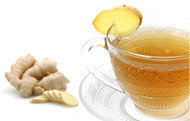Ginger – “To peel, or not to peel?”
Posted by Selina Law on Oct 11th 2018
Ginger is a root that is widely used in not just cuisines around the world but also in many ancient medicinal practices. It has a variety of benefits from bringing relief to sore throat and cold and cough to treating nausea and morning sickness in pregnant women. It is said that Henry VIII used a ginger concoction in hopes of battling against the Plague.

Ginger can be divided into baby ginger, young ginger and old ginger depending on the time of harvest. Its growth period in the ground can range from fewer than seven months to over ten months. Baby ginger is easily recognizable with its thin pale skin, smooth surface, and purple-red scales. Some still have the green stems attached. Young ginger has a thin yellowish skin with no scales. It is what we usually use in both cooking and beverages. Old ginger has thicker and darker skin than both baby and young ginger. The older a ginger, the more layers its skin. When selecting ginger, it is also good to remember that the thicker the skin, the spicier it is.
An easy way to take advantage of the health benefits of ginger and its piquant flavor is to sip ginger tea. A traditional way to make ginger tea is to add freshly grated/sliced ginger into hot black tea and let the mixture brew for several minutes before consumption. Honey or brown sugar may be added to the final infusion. For those who don't like sweet or black tea, and those who are not suitable for taking caffeine, just add hot water to the ginger to make a warm tisane. You may also use herbal ingredients to substitute black tea.

Drinking ginger tea has many health benefits, but should we keep the skin of ginger when we make the tea, or should the skin be peeled off? Does it matter at all?
In reality the amount of ginger used to make a cup of tea should not be enough to make much difference in how the root is prepared. However, if you drink ginger tea regularly and/or in large amount, and if you are dealing with certain ailments, the skin of ginger can either improve or exacerbate your conditions.
"Cool skin, hot flesh" is a common Chinese saying about ginger. It is believed that ginger’s flesh and skin have opposite effect on the human body: its flesh is of warm nature and can aid digestion, stop nausea and enhance detoxification; its skin on the other hand is of cool nature and can reduce swelling.
Therefore, before you can answer the question, “To peel, or not to peel?” you need to determine your current state of wellbeing. For example, if you have a cold and are looking to ginger to alleviate your illness, it is best to peel your root to let its warming properties be fully utilized. If you are suffering from symptoms of constipation, bad breath, mouth ulcers, or other “heat” related problems, it is best to use ginger skin alone in order to cool down your body, or at least use unpeeled ginger in hopes of maintaining a balance. Otherwise, it will be like pouring oil over fire. Your situations will become worse.
The information, including but not limited to, text, graphics, images and other material contained on this website are for informational purposes only. The purpose of this website is to promote broad consumer understanding and knowledge of various health topics related to tea (both true and herbal). It is not intended to be a substitute for professional medical advice, diagnosis or treatment. Always seek the advice of your physician or other qualified health care provider with any questions you may have regarding a medical condition and never disregard professional medical advice or delay in seeking it because of something you have read on this website.

